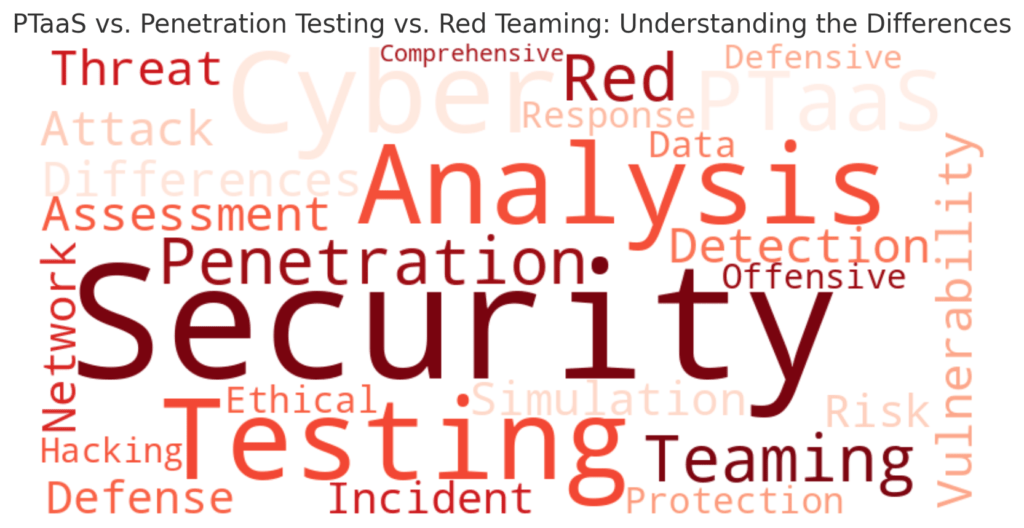
Introduction
In the realm of cybersecurity, various methodologies are employed to assess and enhance the security of IT systems. Among the most notable are Penetration Testing as a Service (PTaaS), traditional Penetration Testing, and Red Teaming. Each of these approaches has unique characteristics, use cases, and benefits. Understanding their differences is crucial for organizations to choose the right method for their security needs.

What is Penetration Testing?
Penetration Testing, often called pentesting, involves simulating cyber attacks on a system, network, or web application to identify security vulnerabilities. Security professionals, known as penetration testers, use various tools and techniques to exploit weaknesses in the system. The goal is to uncover and address vulnerabilities before malicious attackers can exploit them.
What is PTaaS?
Penetration Testing as a Service (PTaaS) is an evolution of traditional penetration testing. PTaaS leverages cloud-based platforms to deliver continuous, on-demand pentesting services. It offers organizations the flexibility to schedule tests, receive real-time updates, and access comprehensive reports through an online portal. PTaaS integrates with development and security workflows, providing ongoing insights and remediation recommendations.
Common Examples of PTaaS
- Cobalt: Provides on-demand penetration testing services with a network of vetted security professionals. Users can schedule tests, receive updates, and view detailed reports through an intuitive platform.
- Synack: Combines automated scanning with human intelligence. Synack’s platform continuously monitors for vulnerabilities and provides real-time feedback and remediation guidance.
- Pentest-Tools.com: Offers a range of penetration testing services, including web application testing, network testing, and vulnerability assessments, all accessible through an online platform.
How Penetration Testing Differs from Red Teaming
Penetration Testing focuses on identifying and exploiting vulnerabilities within a specific scope, such as an application, network, or system. It aims to find as many vulnerabilities as possible within a limited timeframe.
Red Teaming, on the other hand, simulates real-world attacks by acting as adversaries. Red Teams employ a broader range of tactics, techniques, and procedures (TTPs) to test an organization’s detection and response capabilities. The objective is to assess the organization’s overall security posture, including its ability to detect, respond to, and recover from an attack.
How Converge PTaaS Works and Penetration Testing
Converge PTaaS integrates traditional penetration testing methods with a cloud-based platform, offering continuous and on-demand security assessments. Here’s how it works:
- On-Demand Testing: Organizations can request penetration tests at any time, tailored to their specific needs and scope.
- Continuous Monitoring: The platform continuously scans for vulnerabilities, providing real-time alerts and recommendations.
- Integration: PTaaS platforms often integrate with development and security tools, enabling seamless workflows and faster remediation.
- Reporting: Comprehensive reports are accessible through the platform, offering detailed insights into vulnerabilities, exploits, and remediation steps.
When to Choose PTaaS and Penetration Testing
- PTaaS:
- Ideal for organizations that need continuous security assessments and real-time feedback.
- Suitable for agile development environments where frequent testing is required.
- Best for companies looking for cost-effective and scalable security solutions.
- Penetration Testing:
- Suitable for organizations needing a thorough, point-in-time assessment of their security posture.
- Ideal for compliance requirements that mandate periodic security testing.
- Best for companies with a defined scope and specific security concerns.
Conclusion
Choosing between PTaaS, traditional penetration testing, and red teaming depends on the organization’s specific needs and security goals. PTaaS offers flexibility and continuous assessment, making it ideal for dynamic environments. Traditional penetration testing provides a comprehensive, point-in-time evaluation, essential for compliance and focused security assessments. Red teaming offers a broader, more adversarial approach, testing an organization’s overall defense mechanisms. By understanding these differences, organizations can make informed decisions to enhance their cybersecurity posture.
References
- Cobalt: https://cobalt.io/
- Synack: https://www.synack.com/
- Pentest-Tools.com: https://pentest-tools.com/
